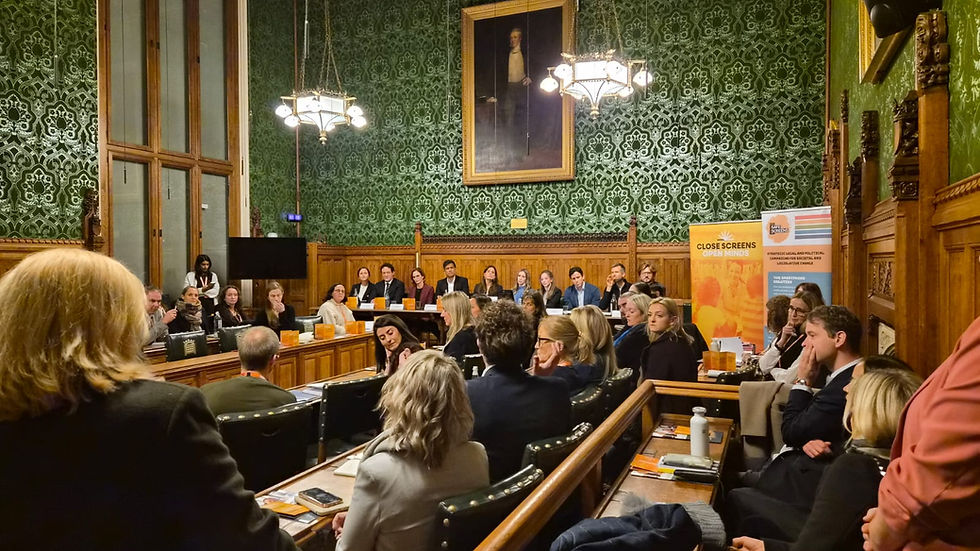AI for Good - Rethinking children’s place in a digital world
- Editorial
- Nov 19, 2024
- 4 min read
Updated: Dec 13, 2024
A recent AI for Good event highlighted insights into how children engage with digital technologies, the opportunities, needs, challenges. There was a sense of default thinking around 'digital futures' which resembles strongly global strategies and initiatives around the 'value creation' and 'cultural shift' for societies to move towards a digital first. The event strongly focused on pressing questions around 'our collective responsibility in shaping this engagement'. However, little consideration is given as to why 'digital futures' and not 'healthy' or 'wellbeing' or 'fulfilling' or 'meaningful' futures.
While technology offers opportunities, there is a need for greater reflection on its purpose and impact before defaulting to integrating digital tools into children’s lives.

Key Issues from discourses that favour 'digital first':
Research gaps and the need for purposeful designs Valuable research gaps were highlighted especially around children’s AI use, impact of disinformation, privacy, and commercial exploitation. While much of this research aims to prioritise child-centred evidence, it overlooks an uncomfortable truth: much of the technology marketed for children prioritises commercial interests over educational or developmental goals. By focusing primarily on what happens and how to mitigate issues such as exploitation or data privacy breaches, such research inadvertently reinforces a 'digital by default' mindset, thus perpetuating the normalisation of technology in children’s lives without critically questioning its broader implications or indeed necessity. Moreover, why are bigger questions never asked such as, for example, what are children truly missing if they are not hanging around TikTok and Instagram, Roblox and Snapchat?
To paraphrase Hannah Arendt, adults often expect younger generations to fix the world they’ve compromised, while still dictating how it should be done. Ironically, the experts advocating for a 'digital future' for children grew up with none of these technologies themselves—and turned out fine (to be in the positions they are). Such discussions risk overlooking critical questions and instead fuel a moral panic: a fear of missing out if children aren’t immersed in the digital.
Andrea Blasco’s research into large language models (LLMs) revealed both potential and pitfalls. For instance, AI's ability to offer step-by-step reasoning can aid learning, but findings also showed minimal impact on confidence and deeper engagement. These results mirror larger concerns: Are we deploying AI in classrooms because it genuinely enhances learning—or because it is a convenient solution to modern pressures?

Others explored conversational agents revealing a striking 'observation': children form emotional bonds with AI, even in limited contexts. This, of course, boggles the mind as to why this is news. Insights from fields such as developmental psychology, social psychology, sociology, ethology...and even real-life observations—also spilled through endless media programs, articles, human stories, literature (who remembers the Velveteen Rabbit by Margery Williams?), and music, have told us numerous times that children have the capacity to form emotional attachments to people, animals, and even something as simple as a blanket. The critical focus should be on the actual ethical concerns about the long-term effects of fostering relationships with machines and a growing dependency on them. As society—specifically among policymakers and some academics and much of industry—increasingly pushes young people into digital environments, we must critically assess whether these connections enrich their lives—or risk alienating them from real-world relationships and self-discovery.

A framework for responsible innovation from Sesame Workshop was also promoted. It offers 'a roadmap for safety and inclusivity in digital design' - initiated by LEGO, the luxurious plastic brick toy company, and UNICEF. The OECD has one, the Digital Futures for Children centre has one, the World Economic Forum has one, the Council of Europe has one, there is also an African Union one, and all the digital businesses surely have their own. Most of these circulate around similar principles, yet, like businesses, they all seem to propose their own versions on the market shelf. That said, even the best frameworks are meaningless without a fundamental question:
Do these tools align with children’s needs and what's desirable for their growth; for them to learn self-control, how to move away from their 'egocentric' desires; how to move beyond the 'desire to know into a desire to learn'; how to 'resist the temptation or the influence of a given object, person or group'; how to 'move beyond himself to hear and understand the points of view of others'; and how to 'disassociate knowledge and belief', and drive for precision and truth (as Philippe Meirieu argues)—or do they merely funnel them into a tech-dominated existence by default?
Rethinking the 'digital futures for children' by default
The push for children to adopt digital tools often assumes their inherent benefit without critically evaluating whether they foster meaningful learning, well-being, or human connection. Before making technology the norm in young lives, while already well underway due to a strong push from some academia, most media, policy, and all of industry (even those traditionally non-digital), society must reflect on its goals. Are we nurturing independent thinkers and creators—or shaping a generation beholden to systems they don’t control?
The potential of AI (as Yuval Harari calls it 'alien intelligence', not in the least 'artificial' as though it is planted like plastic, which can be discarded just like plastic) is undeniable. But its role must be guided by a deeper sense of purpose, not convenience or profit. Even then we cannot guarantee a digital future where children thrive, not if the non-digital human future suffers from neglect and deteriorates.



Comments